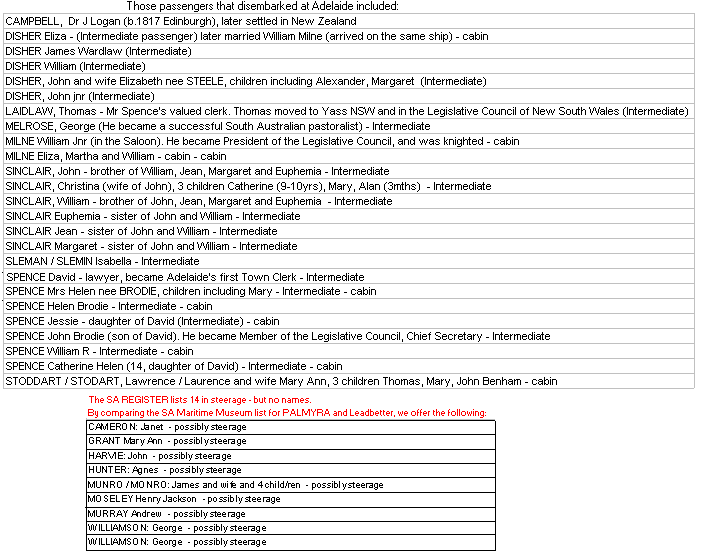PALMYRA 1839on her maiden voyage. On July 7th when near Tuskar Rock light (in the Irish Sea) a barque ran foul of her in the night while in the act of 'staying' and carried away her cutwater, bowsprit, foremast and main topmast. The PALMYRA was therefore obliged to put back to Greenock for repairs, and left that port on July 20th, 1839. The PALMYRA arrived at Port Adelaide (known as Port Misery) on Tuesday October 29th, 1839. The SUPERB which left Greenock on July 11th, 1839 arrived in Adelaide on the same day as the PALMYRA (October 29th). Both ships carried passengers intended for Adelaide, Melbourne and Sydney. |
 Click the ship to see a larger image |
 |
|
CATHERINE HELEN SPENCE's memoirs mention: There were 150 passengers, mostly South Australian immigrants, in the little ship. The first and second class passengers were bound for Port Philip and Sydney in greater proportion than for Adelaide. The PALMYRA was advertised to carry a cow and an experienced surgeon. Intermediate passengers had no more advantage of the cow than steerage folks, and except for the privacy of separate cabins and a pound of white biscuit per family weekly, we fared exactly as the other immigrants did, though the cost was double. Twice a week we had either fresh meat or tinned meat, generally soup and boudle, and the biscuit seemed half bran, and sometimes it was mouldy. But our mother thought it was very good for us to endure hardship, and so it was. (The concession of white biscuit for the second class for one day in the week was obtained following the delay caused by needed repairs to the PALMYRA at the beginning of the voyage). in the intermediate was Miss Eliza Disher, his future wife. He became President of the Legislative Council, and was knighted. John Brodie Spence (brother of Catherine Spence) sat in the Council, and was at one time Chief Secretary. His father's valued clerk was Thomas Laidlaw, who became a member of the Legislative Council of New South Wales. A prominent citizen in the town of Yass, "Honest Tom of Yass" was his soubriquet. Another passenger George Melrose became a successful South Australian pastoralist. |
Of all those on board the young doctor, JOHN LOGAN CAMPBELL (1817-1912) has had the most distinguished career. He was born in Edinburgh and was the only surviving son of Dr John Campbell of Aberuchill and Kilbryde. Young John took his medical degree in 1839 and sailed for Australia in the July of that year. He celebrated his twenty-first birthday while the Palmyra was lying off Holdfast Bay (now Glenelg) before arriving at the old Port Adelaide to discharge. At Adelaide William Brown, a Dundee lawyer, and his wife joined the PALMYRA and made friends with the young surgeon. (William BROWN and his wife had left Dundee on board the INDUS, and arrived in Adelaide on January 17, 1839). They parted at Sydney as the Browns were moving on to New Zealand. J.C. Campbell never again formally practised medicine. But neither did he take up sheepfarming. Of that ambition he was soon cured when he made an inland tour of New South Wales during a drought stricken summer. Instead, in March 1840, he left Australia on the LADY LILFORD for New Zealand. In June 1848 he seized an opportunity to make an extended tour through the Middle East, Greece, Italy and western Europe, culminating in a visit to his family in Edinburgh. Shortly after his return to New Zealand, Campbell was off again - this time to California. Not long after his return to New Zealand, he purchased land at Maungakieke (One Tree Hill). Campbell presented most of this land, now known as Cornwall Park, to the people of Auckland in 1901. Next to Sir George Grey, Campbell has had most to do with the development of New Zealand. He became Sir John Campbell on June 26th 1902. In his book "Poenamo," written for his children, there is a picture of the PALMYRA, with an account of the voyage. He is now called the Grand Old Man of Auckland. |
Bound for Melbourne were Mr. and Mrs. Duncan, of Melrose, and Charles Williamson, from Hawick, who founded a great business house in Collins Street. There were Langs from Selkirk, and McHaffies, who became pastoralists. Our next cabin mate, who brought out a horse, had the Richmond punt when there was no bridge there. One of the steerage passengers (unidentified) was a servant girl to the Spence family. As the family had arranged purchase of an 80-acre section, this entitled them to the steerage passage of four adults. The difference between steerage and intermediate fares had to be made up. |
